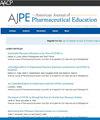Implementation and Effectiveness of an Immersive Continuing Professional Development Elective for Student Pharmacists During the COVID-19 Pandemic
IF 3.5
4区 教育学
Q1 EDUCATION, SCIENTIFIC DISCIPLINES
引用次数: 0
Abstract
Objective
To examine the implementation and effectiveness of a continuing professional development (CPD) elective for fourth-year student pharmacists.
Methods
A 4-week, remote CPD elective was developed and implemented during the COVID-19 pandemic for the Class of 2021. Students worked through each step of the CPD cycle, logged activities that facilitated the achievement of self-identified goals, and submitted a final CPD portfolio and written reflection describing their experience applying the CPD approach. Data were collected using in-depth, semistructured interviews and electronic, web-based surveys. Early implementation outcomes measured included acceptability, appropriateness, and feasibility. The interview guide was based on the Consolidated Framework for Implementation Research.
Results
All CPD elective students (100%, n = 80) completed course requirements and surveys and passed the course. Implementation outcomes were 83.4% acceptability, 93% appropriateness, and 86.6% feasibility. Students reported full (62.9%) or partial (35%) achievement of self-identified goals and satisfaction with their learning outcomes (92.5%). Compared to Class of 2021 students not taking the elective, CPD elective students were more likely to have used a structured tool to identify professional strengths, areas of improvement, and learning opportunities, and to document a learning plan to achieve their goals. Twelve students participated in interviews. Students responded positively to the CPD experience and recognized the value of CPD training in achieving professional goals and preparing for lifelong learning. Participants appreciated the personalization, autonomy, and flexibility the elective offered, which increased perceived motivation and engagement in the learning process.
Conclusion
The CPD elective provided an acceptable, appropriate, feasible, and effective CPD experience within the PharmD curriculum. Findings may be used to support the development of future CPD activities within pharmacy education.
COVID-19大流行期间学生药剂师沉浸式持续专业发展选修课的实施和有效性
目的:探讨四年级药学专业学生持续专业发展(CPD)选修课的实施和有效性。方法:在2019冠状病毒病大流行期间,为2021届学生制定并实施了为期4周的远程CPD选修课。学生们完成了CPD周期的每一步,记录了促进实现自我确定目标的活动,并提交了最终的CPD作品集和书面反思,描述了他们应用CPD方法的经验。数据是通过深度、半结构化访谈和基于网络的电子调查收集的。早期实施结果测量包括可接受性、适当性和可行性。访谈指南基于实施研究综合框架(CFIR)。结果:所有CPD选修学生(100%,n=80)均完成课程要求和调查并通过课程。实施结果可接受性为83.4%,适宜性为93%,可行性为86.6%。学生表示完全(62.9%)或部分(35%)实现了自我确定的目标,对学习成果感到满意(92.5%)。与未选修CPD课程的2021届学生相比,CPD选修课程的学生更有可能使用结构化工具来识别专业优势、改进领域和学习机会,并制定学习计划以实现目标。12名学生参加了面试。学生对持续专业进修经历的反应积极,并认识到持续专业进修培训在实现职业目标和为终身学习做准备方面的价值。参与者欣赏选修课提供的个性化、自主性和灵活性,这增加了学习过程中的感知动机和参与度。结论:CPD选修课在药学博士课程中提供了一个可接受的、适当的、可行的和有效的CPD体验。研究结果可用于支持药学教育中未来CPD活动的发展。
本文章由计算机程序翻译,如有差异,请以英文原文为准。
求助全文
约1分钟内获得全文
求助全文
来源期刊
CiteScore
4.30
自引率
15.20%
发文量
114
期刊介绍:
The Journal accepts unsolicited manuscripts that have not been published and are not under consideration for publication elsewhere. The Journal only considers material related to pharmaceutical education for publication. Authors must prepare manuscripts to conform to the Journal style (Author Instructions). All manuscripts are subject to peer review and approval by the editor prior to acceptance for publication. Reviewers are assigned by the editor with the advice of the editorial board as needed. Manuscripts are submitted and processed online (Submit a Manuscript) using Editorial Manager, an online manuscript tracking system that facilitates communication between the editorial office, editor, associate editors, reviewers, and authors.
After a manuscript is accepted, it is scheduled for publication in an upcoming issue of the Journal. All manuscripts are formatted and copyedited, and returned to the author for review and approval of the changes. Approximately 2 weeks prior to publication, the author receives an electronic proof of the article for final review and approval. Authors are not assessed page charges for publication.

 求助内容:
求助内容: 应助结果提醒方式:
应助结果提醒方式:


